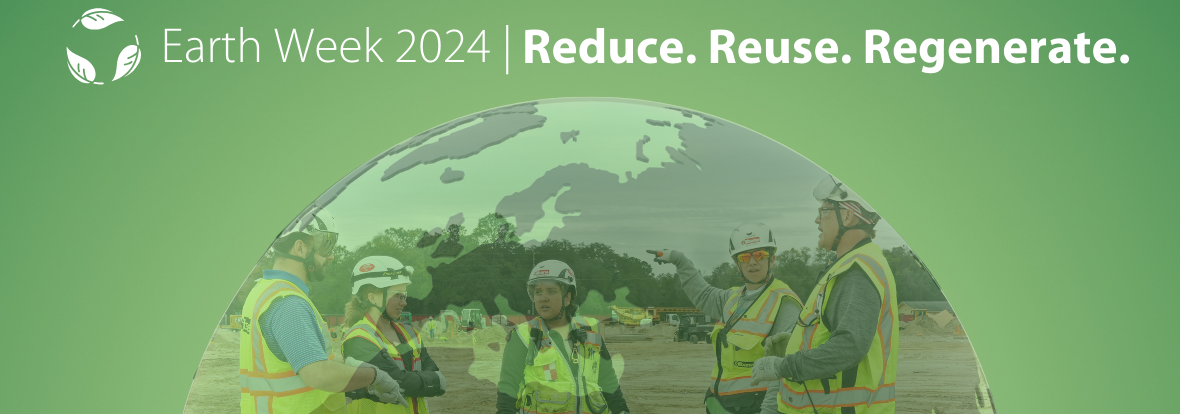In celebration of Earth Week at Gilbane, we are excited to present a special Q&A session with our Executive Sustainability Officer Tabitha Scott. This conversation delves into the heart of our commitment to sustainability, exploring the principles that guide our approach and the innovative strategies we employ to make a positive impact on the environment.
Q: What inspired you to work in sustainability at Gilbane?
A: I grew up on a small farm in Kentucky, so having that opportunity to interact with animals and family to explore, plant, and experience firsthand the perfect balance of nature was priceless! I loved getting my hands dirty—and learning things that influenced and informed my career in business. Like diversifying crops to mitigate risks and increase productivity and using waste to create fertilizer for the garden. Further, living out there gave me the freedom to invent things from what we had leftover—like taking old wheels from the barn to build my own chariot to be pulled by my valiant steed Peppi (our one-eyed Dalmatian). Similarly, in businesses, I think a lack of resources can also become a catalyst for creativity instead of just a constraint.
I’m working in sustainability today because I’m still that curious farmer. What should we grow this year? What are the risks that could impact that? How can we take the waste from one thing and turn it into the catalyst to grow something else? Are we making the best use of every resource we’ve got here (financial, human, materials, energy, water etc.)? We find ourselves sitting at this epic point in history where the natural balance and connection that existed for over 4 billion years has been disrupted, starting with the Industrial Revolution, and spiraling into complex challenges like pollution, health problems, resource shortage, climate change, and being disconnected, distracted, and burned out.
When I heard about Gilbane making its bold commitment to becoming net zero waste and energy, I wanted to be part of that positive change. We have this chance to pivot from the ways of the past and rebuild our communities in a restorative way. Looking across the construction sector, which accounts for an estimated 37% of global emissions, no other industry has such a profound opportunity to make a positive impact by pivoting its practices. I’m so excited to be a part of this journey and leveraging opportunities to improve the way the construction industry builds!
Q: Tell us about the opportunity for construction to impact sustainability.
A: What if the construction sector shifted its thinking from “do no harm” to “building more than buildings”? Our focus could be on rebuilding and restoring the earth, not just mitigating negative impacts. For example, there is no waste in nature—the end of one thing is the beginning of another. Similarly, the more Gilbane shifts to a circular process, the more time, money, energy, water, and materials we save. What’s more, in a circular economy, we’re constantly regenerating improvements, so it stimulates long-term, sustainable growth. Regeneration is an important principle for us because it’s smart business. If we’re making the best use of all our resources (including people, financial, and natural) then we’ll find ourselves becoming increasingly successful. Regenerative construction has a positive impact on people and nature, today and tomorrow, with the purpose of leaving a positive legacy for future generations.
Q: How does Gilbane apply the principles of “Reduce. Reuse. Regenerate.” in its projects and/or in its business operations?
A: At Gilbane, regenerative construction means building in a way that has a positive impact on people and the planet. It’s building places that provide a positive legacy for today and tomorrow. It values every single voice—every pair of boots on the ground—as we get better and better over time. Think about it, what in nature grows from the top down? Growth always comes from the power of “we”, not just “me” and it shows up in thousands of ways – sharing knowledge, connecting networks, refining processes, or any number of actions that will leave communities better than we found them.
Each of us has unique training, skills, and curiosity, so there’s not a “one size fits all” approach. Here are a few strategies to spark change on our projects and in our offices:
- Reduce – In every aspect of our projects and operations, people can assess ways to do more with less (effort, cost, carbon, energy, water etc.)
- Reuse – The more waste we can divert from landfills, the lower our hauling fees and less our emissions created, so every time we reuse something, it benefits Gilbane in multiple ways.
- Regenerate – We had some great examples of regeneration from Gilbane projects in our Impact Series session recently.
Q: Where do you see the greatest opportunity for impact in terms of reducing carbon in the built environment through construction?
A: The biggest opportunities for impact are for each person to think about every process and material they’re using and consider how we may reduce transportation, volume needed, have more sustainable materials and so on. In preconstruction, for example, we have the capability to use the EC3 tool to estimate carbon alongside other “costs” for a particular project. Imagine if we just started to look at our most carbon intense materials and made some small shifts now that will be amplified over time into significant reductions—it’s not complicated, just a small habit shift can helpchange our trajectory.
Q: How is innovation driving sustainability in construction?
A: Gilbane has a great innovation program, led by Kelly Benedict with support from other areas like our technology group! I’m impressed with the innovative solutions they’re reviewing, like CarbonCure, which injects captured CO₂ into fresh concrete to reduce its carbon footprint, without compromising performance. Once injected, the CO₂ undergoes a mineralization process and becomes permanently embedded in the concrete. This results in economic benefits and reduced carbon emissions in the air—truly a win-win. Our company has a long-standing legend of doing that already, so I see that continuing into the future.

